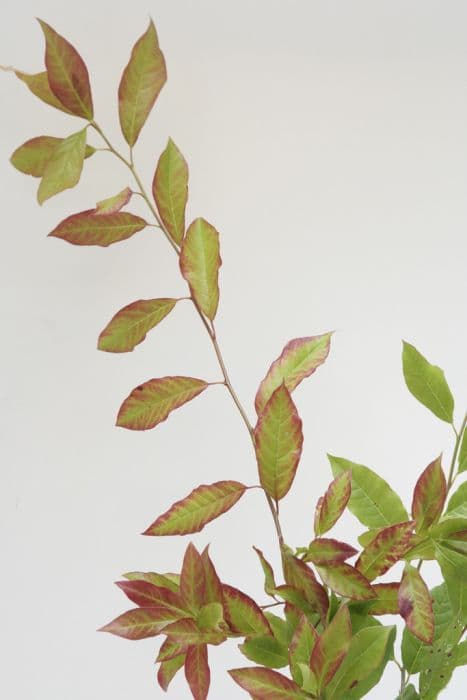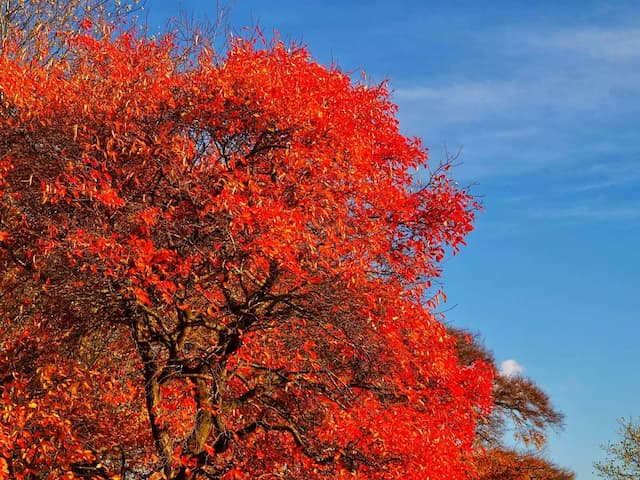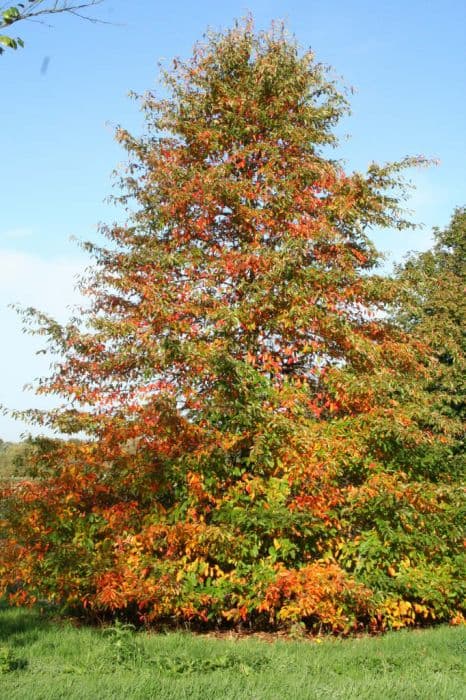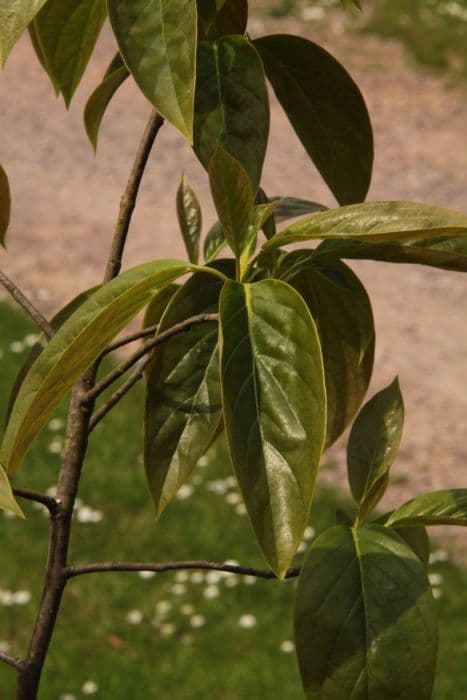Dove Tree Davidia involucrata











ABOUT
Davidia involucrata, commonly known as the dove tree or handkerchief tree, is a unique and attractive deciduous tree. One of its most distinctive features is the large white bracts that surround the small, inconspicuous flowers, giving the appearance of handkerchiefs or doves sitting on the branches, which has led to its common names. This characteristic happens during the spring, creating a dramatic and showy display. The leaves of the dove tree are heart-shaped or broadly ovate and have a pointed tip. They are simple and alternate along the branches, showcasing a vibrant green color that can turn to yellowish or reddish shades in the fall, adding seasonal interest to the landscape where the plant is situated. The fruit of the dove tree is a hard, nut-like structure, and it hangs on the tree encased in a husk. The tree itself has a broadly pyramidal form when young, becoming more spreading and irregular with maturity, with the branches sometimes taking on a slightly weeping habit. The bark is grey-brown, often becoming ridged or furrowed in a network pattern as the tree ages. Overall, the dove tree presents a graceful appearance in any garden or park, with its unique flowering bracts being the main spectacle that draws attention and admiration.
About this plant
 Names
NamesFamily
Nyssaceae
Synonyms
Dove Tree, Handkerchief Tree, Pocket Handkerchief Tree, Ghost Tree
Common names
Davidia laeta, Davidia tibetana, Davidia vilmoriniana, Davidia involucrata var. vilmoriniana, Davidia involucrata var. laeta.
 Toxicity
ToxicityTo humans
The Dove Tree is not known to be toxic to humans. No significant toxicity has been reported from ingesting parts of the Dove Tree.
To pets
The Dove Tree is also not known to be toxic to pets. It is not commonly reported to cause any significant symptoms of poisoning or adverse consequences if pets ingest parts of it.
 Characteristics
CharacteristicsLife cycle
Perennials
Foliage type
Deciduous
Color of leaves
Green
Flower color
White
Height
20-40 feet (6-12 meters)
Spread
15-30 feet (4.5-9 meters)
Plant type
Tree
Hardiness zones
6-8
Native area
China
Benefits
 General Benefits
General Benefits- Ornamental Value: Davidia involucrata, commonly known as the dove tree, is highly valued for its unique and ornate flowers that resemble handkerchiefs or doves, making it a striking addition to landscape design.
- Shade Providing: With its large, wide canopy, the dove tree can provide a significant amount of shade, creating cooler areas in gardens and parks.
- Wildlife Attraction: The flowers of the dove tree can attract pollinators such as bees, while the fruit can be a food source for birds, thus enhancing biodiversity.
- Seasonal Interest: The dove tree has distinct seasonal changes, from its floral display in spring to its leaf color transformation in autumn, adding year-round interest to an environment.
- Educational Value: Due to its unusual flowers and rarity in cultivation, the dove tree offers educational opportunities for those interested in botany and horticulture.
- Cultural Significance: The dove tree has cultural importance in its native China and is cherished in horticulture circles around the world, often being a centerpiece in botanical collections.
 Medical Properties
Medical PropertiesThis plant is not used for medical purposes.
 Air-purifying Qualities
Air-purifying QualitiesThis plant is not specifically known for air purifying qualities.
 Other Uses
Other Uses- Symbol of rarity and conservation efforts: As the Dove Tree is a rare species, it's often planted in botanical gardens and arboretums around the world to symbolize the importance of plant conservation.
- Collectible horticultural specimen: Due to its unique bracts and rarity, Dove Tree is sought after by horticulture enthusiasts, which can drive interest in rare plant collection.
- Educational tool in botany: The Davidia involucrata serves as an educational example of plant evolution and speciation, often discussed in academic settings.
- Woodworking material: The wood of the Dove Tree is sometimes used in the craft of woodworking, albeit infrequently due to its scarcity and the tree's ornamental value.
- Inspiration for art and design: The distinct shape of the Dove Tree's bracts can inspire patterns and motifs in art, textiles, and design work.
- Focal point in landscape design: With its striking appearance when in bloom, it is commonly used as a focal point tree in garden design and landscaping projects.
- Cultural symbol: In areas where it is native, the Dove Tree may hold cultural significance and be incorporated into local traditions and folklore.
- Arboriculture education: Professionals and students in the field of arboriculture may use the Dove Tree as part of studies on care, pruning, and planting of ornamental trees.
- Seasonal celebrations: Because of its captivating spring blossoms, the tree can be incorporated into festivals and events that celebrate springtime.
- Photography subject: The unique visual appeal of the Dove Tree, especially when flowering, makes it a sought-after subject for photographers and nature enthusiasts.
Interesting Facts
 Feng Shui
Feng ShuiThe Dove Tree is not used in Feng Shui practice.
 Zodiac Sign Compitability
Zodiac Sign CompitabilityThe Dove Tree is not used in astrology practice.
 Plant Symbolism
Plant Symbolism- Peace: Davidia involucrata, commonly known as the Dove Tree, features flowers that resemble doves perched on the branches, symbolizing peace and serenity.
- Purity: The white bracts of the Dove Tree are reminiscent of purity, often invoking a sense of innocence and cleanliness.
- Beauty: With its unique and stunning appearance when in bloom, the Dove Tree is a symbol of natural beauty and the wonders of the natural world.
- Spirituality: The Dove Tree, with its tranquil and graceful aspects, is sometimes associated with spiritual elevation and the quest for inner peace.
 Water
WaterThe Dove Tree should be watered deeply and thoroughly to encourage a strong root system, typically once a week during its growing season in the absence of rainfall. Aim to provide about 1-2 gallons per watering session, depending on the tree's size and the soil's moisture level. During the winter months, water less frequently, just enough to prevent the soil from drying out completely. It's crucial to adjust watering based on the climate, with less water needed in cool, humid environments and more in hotter, drier areas. Ensure the tree is not left sitting in soggy soil to avoid root rot.
 Light
LightFor optimal growth, the Dove Tree prefers a spot with full sun to partial shade. Best results are often seen when the tree is planted in a location that receives morning sunlight followed by afternoon dappled shade or in areas with filtered light throughout the day. Avoid deep shade positions, as this can lead to reduced flowering and overall vitality of the tree.
 Temperature
TemperatureThe Dove Tree thrives in temperatures typically found in USDA hardiness zones 6 through 8, enjoying a moderate climate. It can survive minimum temperatures down to about 0°F and is comfortable in summer temperatures that do not often exceed 85°F. The Dove Tree is cold hardy but should be protected from severe frosts and extremely high temperatures, which can damage the plant.
 Pruning
PruningThe Dove Tree requires minimal pruning, mainly to remove any dead, diseased, or damaged branches and to maintain a pleasing shape. Pruning should be carried out in late winter or early spring before new growth starts. It is also a good time to remove any suckers or unwanted shoots to encourage healthier growth of main branches. Do not over-prune as this can harm the tree's natural form.
 Cleaning
CleaningAs needed
 Soil
SoilThe Dove Tree (Davidia involucrata) thrives in well-drained, fertile soil with a pH range of 6.5 to 7.0. A good mix for this tree would consist of loam, compost, and leaf mold or rotted manure to encourage healthy growth and flowering.
 Repotting
RepottingThe Dove Tree is typically grown as a landscape tree rather than in containers, so repotting is not commonly practiced. However, if grown in a container, young trees may need repotting every few years until they are planted out.
 Humidity & Misting
Humidity & MistingThe Dove Tree prefers moderate humidity levels but is quite adaptable to different conditions as long as it's not in an extremely dry environment; no specific humidity level is required.
 Suitable locations
Suitable locationsIndoor
Grow Dove Tree in large pots with drainage; place in bright, indirect light.
Outdoor
Plant Dove Tree in partial shade; protect from strong winds.
Hardiness zone
6-9 USDA
 Life cycle
Life cycleThe Dove Tree (Davidia involucrata) begins its life cycle when a seed germinates, usually requiring stratification to break dormancy. After germination, the seedling progressively develops into a juvenile tree, with its distinctive heart-shaped leaves emerging. As it grows into maturity, which can take several years, it eventually starts to develop its characteristic flowers, which are actually small and inconspicuous but are surrounded by large, white bracts that give the appearance of handkerchiefs or doves, hence its name. These bracts attract pollinators, such as bees, allowing for cross-pollination. Following successful pollination, the tree produces small, round fruits containing seeds, which, when mature, are dispersed by gravity and possibly by animals. The mature Dove Tree can live for many decades, flowering annually in the spring, and the cycle is repeated with the germination of new seeds.
 Propogation
PropogationPropogation time
Spring to Summer
The Dove Tree, known botanically as Davidia involucrata, is typically propagated through seed. This is the most popular method employed due to the plant's recalcitrant nature when it comes to other forms of propagation like cuttings or grafting. To propagate the Dove Tree by seed, the best time is in the fall, immediately after the drupe-like fruits have maturely ripened. The seeds should be thoroughly cleaned and stratified for a period of 60-90 days at temperatures between 33-41°F (0.5-5°C) to break dormancy. Once stratified, the seeds are sown in well-drained soil and should be kept moist until germination, which can be slow and may take several months. Seedlings are typically grown on for at least a couple of years before being large and robust enough to plant out in their permanent positions.




